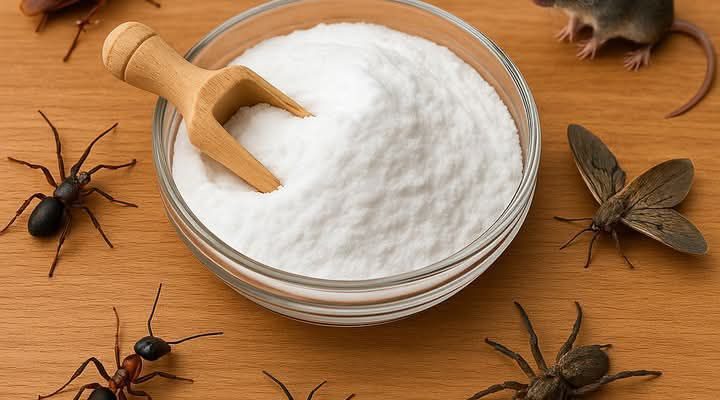Natural Pest Control with Baking Soda: A Step-by-Step Guide 🧂🐜
If you’re tired of toxic chemicals and expensive exterminators, it’s time to explore one of the most affordable and effective natural solutions sitting in your pantry: baking soda. This simple compound—sodium bicarbonate—is more than just a leavening agent. It’s a powerful, non-toxic weapon against some of the most common household pests. From cockroaches and ants to fleas, moths, and even mice, baking soda disrupts their systems, repels them naturally, and leaves your home safer and fresher.
In this step-by-step guide, we’ll show you how to use baking soda effectively for pest control, what it does, and where to apply it for the best results. Whether you’re protecting your home, your garden shed, or your storage closet, these DIY methods give you safe, budget-friendly alternatives that actually work.
1. Cockroaches
How It Works:
Baking soda reacts with the acid in a roach’s digestive system, creating internal gas buildup. Since roaches can’t release gas like humans can, this leads to internal rupture and death. When combined with sugar, which acts as a bait, this method becomes a lethal trap.
What to Do:
Mix equal parts baking soda and white sugar (e.g., 2 tbsp of each).
Spoon into shallow lids, bottle caps, or jar lids.
Place them in roach-prone areas: under sinks, behind refrigerators and stoves, along baseboards, and inside dark cupboards.
Check and refresh every 2–3 days.
Bonus Tip: Place a small dish of water nearby. Roaches will drink after eating, which activates the baking soda more effectively.
2. Ants
How It Works:
Ants are drawn to sugar, but the baking soda they consume interferes with their digestion and ultimately kills them. It also disrupts their scent trails, making it harder for colonies to follow established paths.
What to Do:
Mix 1 part baking soda with 1 part powdered sugar.
Sprinkle lightly along ant trails, windowsills, entryways, or cracks where ants appear.
Reapply after cleaning or heavy vacuuming.
Pro Tip: If using outside, place the mixture under a small upside-down container with entry holes to keep it dry.
3. Fleas
How It Works:
Baking soda draws moisture from flea eggs and larvae, dehydrating them. It also damages their exoskeletons when in contact, slowing reproduction. When combined with thorough vacuuming, this method becomes highly effective against indoor flea infestations.
What to Do:
Sprinkle a generous amount of dry baking soda onto carpets, pet bedding, rugs, and upholstery.
Use a brush or broom to work the powder into fabric fibers.
Leave it in place for 12–24 hours.
Vacuum thoroughly. Dispose of the vacuum bag or clean the canister outdoors.
Extra Step: Repeat every 3–5 days during active flea cycles for ongoing protection.
Note: Always keep pets off treated areas during activation.
4. Moths
How It Works:
Moths dislike dry, alkaline environments. Baking soda absorbs moisture and odors that attract them, and acts as a passive deterrent in clothing storage spaces. It also keeps the environment unappealing for moth larvae.
What to Do:
Fill small cloth sachets, jars, or open containers with baking soda.
Place them inside closets, drawers, storage boxes, and wardrobes.
Replace monthly or when clumping occurs.
Optional Add-On: Mix in dried lavender flowers or a few drops of lavender essential oil to boost repellency and add fragrance.
5. Mice and Rats
How It Works:
Rodents cannot burp or pass gas. When they ingest baking soda, the gas buildup becomes lethal. Mixed with attractive bait like peanut butter, baking soda becomes a silent, poison-free rodent solution.
What to Do:
Mix 1 part baking soda with 1 part peanut butter or cocoa powder.
Form small bait balls or place spoonfuls in jar lids, wax paper, or small trays.
Set in rodent-prone zones: attics, basements, behind appliances, pantries, and garage corners.
Check regularly and refresh as needed.
Caution: Keep out of reach of pets and children. Use in areas they can’t access.
6. Spiders
How It Works:
Spiders avoid dry, dusty substances and dislike the texture and alkalinity of baking soda. It acts more as a barrier deterrent than a killer, keeping them from entering or nesting in specific areas.
What to Do:
Sprinkle baking soda in doorways, window ledges, under furniture, in closet corners, and basement edges.
Reapply after cleaning, sweeping, or any moisture exposure.
Tip: Add peppermint essential oil to enhance deterrent power. Spiders hate the scent and will avoid treated areas.
Extra Tips for Best Results
1. Refresh Frequently: Baking soda loses its effectiveness when it absorbs moisture. Reapply every few days, especially in humid areas.
2. Keep It Dry: Always apply to dry surfaces and store mixtures in airtight containers when not in use.
3. Combine with Essential Oils: Mix baking soda with a few drops of peppermint, eucalyptus, tea tree, lavender, or citronella oil for extra pest repelling power.
4. Label Homemade Mixes: Always mark your DIY pest control jars or sachets clearly to avoid confusion or misuse.
5. Pet Safety: Use caution with peanut butter baits or scented mixtures. Keep all traps and powders away from curious pets.
What Gardeners and Homesteaders Say
Jessica Sowards (Roots and Refuge): “Baking soda is a homesteader’s best friend. It’s always in use—from cleaning to pest control.”
Kevin Espiritu (Epic Gardening): “In small doses, baking soda can be a surprisingly powerful pest deterrent. Just don’t overdo it.”
Melissa K. Norris: “We’ve used it around the cabin for everything from roaches to musty closets. It’s simple, safe, and works.”
Joe Lamp’l: “If you’re looking for a non-toxic fix for ants or spiders, this is a great place to start.”
Garden Betty (Linda Ly): “I use it in drawers, pet zones, and even sprinkle it on outdoor steps. It’s versatile and natural.”
10 Frequently Asked Questions (FAQs)
1. Is baking soda safe around pets and kids?
Yes—for most uses. Avoid direct ingestion or placing bait mixtures where pets or kids can access them.
2. Can I use baking soda on my plants for pest control?
Yes—in diluted sprays. For example, 1 tbsp baking soda + 1 quart water + 1 tsp soap makes a mild fungicide.
3. How do I store homemade traps or sachets?
Use airtight containers and label them. Keep in a cool, dry location.
4. Will baking soda kill bed bugs?
Not reliably. It may irritate them, but it’s not a proven standalone treatment.
5. Can I mix baking soda with vinegar for pest control?
Only for cleaning. The chemical reaction cancels out the pest control benefits.
6. Is it better than commercial sprays?
For light infestations, yes. Severe issues may require professional treatment.
7. Does baking soda lose strength over time?
It can if exposed to moisture. Keep it sealed when not in use.
8. Can I use it outside?
Yes—apply in dry, protected areas. Avoid use before rain.
9. How long does it take to see results?
Roaches and ants may take 2–5 days. Rodents vary. Spiders avoid treated areas immediately.
10. Will pests return?
Possibly. Repeat applications and seal entry points for best long-term control.
Final Thoughts
Baking soda isn’t just for baking cookies or cleaning your sink. It’s a surprisingly versatile and powerful tool for natural pest control around the home and garden. From dehydrating fleas and killing roaches to deterring spiders and moths, this safe, affordable ingredient offers a chemical-free way to reclaim your space.
With a few pantry staples, some smart placement, and regular reapplication, you can keep your living spaces pest-free—and skip the harsh chemicals in the process. Try one method or all six and experience the quiet power of baking soda in your pest defense plan.
Must express something to keep getting my recipes… Thank you!


